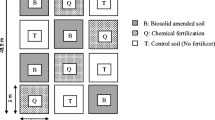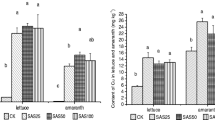Abstract
Recycling sewage sludges as fertilisers on soils for crop production has several potential benefits such as providing large amounts of phosphorous and organic matter. However, the spreading of urban sewage sludge is a constant cause of controversy because it is known to introduce potentially toxic trace metals into the soil, particularly cadmium. In order to clarify this debate, this review article presents a synthesis of the results of several studies carried out in France on the impact of sewage-sludge spreading. This article reports mainly Cd results but also some results on other trace metals such as Cr, Cu, Hg, Ni, Pb and Zn. Two kinds of data are presented: (1) soil data including total metal contents and data from partial extraction to evaluate the phytoavailable fractions, and (2) plant data including metal content of wheat, a major agricultural crop. The field experiments involved very different amounts of applied sewage sludges and Cd. Indeed, three categories of experiments stand out, the first and second involving high amounts of applied Cd, and the third involving low amounts of applied Cd: (1) during the 1970s and ’80s, sludges with a high trace metal content, especially Cd, were spread at the INRA trials at Couhins experimental farm on sandy soils and in the Vexin area on silty topsoils. The quantities of applied Cd were very high, ranging from 3600 g to 641 000 g per ha. Here, the results show a notable impact on total Cd contents of topsoil and cereal grains. (2) Sludges containing high levels of industrial cadmium were spread on acid soils in the Limousin region for more than twenty years up to 1998. Topsoil Cd contents were measured in fields where the cadmium input was highest, of 300 to 600 g Cd per ha. Here, a clear increase in the Cd content of cereal grains was found. (3) During the 1990s and 2000s, numerous experiments with sewage-sludge applications compatible with the new French regulations of 1998 were implemented. The amounts of applied Cd were therefore much lower, from 0.6 to 270 g/ha. Here, no impact was detected on the composition of cereal grains. This review article concludes that the application of huge quantities of sewage sludges in the 1970s and ’80s had a clear and long-lasting effect on both soil and grain Cd compositions. Nonetheless, spreading sewage sludge in accordance with the new French regulations had no significant impact on soil and cereal-grain Cd concentrations.
Similar content being viewed by others
References
AFNOR (1996) Qualité des sols. Mise en solution totale par attaque acide, Norme NF X 31–147.
Baize D. (1997) Teneurs totales en éléments traces métalliques dans les sols (France), Références et stratégies d’interprétation, Chap. 25 et 27, INRA Éditions, Paris, 410 p.
Baize D., Tomassone R. (2003) Modélisation empirique du transfert du cadmium et du zinc des sols vers les grains de blé tendre, Étude et Gestion des Sols 4, 219–238.
Baize D., Tomassone R. (2005) Prédiction de la teneur en cadmium du grain de blé tendre á partir de mesures sur échantillons de sols, Journées techniques “Transfert des polluants des sols vers les végétaux cultivés et les animaux d’élevage”, ADEME Paris, pp. 5–14.
Baize D., Deslais W., Gaiffe M. (1999) Anomalies naturelles en cadmium dans les sols de France, Étude et Gestion des Sols 2, 85–104.
Baize D., Mench M., Sappin-Didier V., Mocquot B., Gomez A., Proix N., Sterckeman T. (2003) Phytodisponibilité des éléments traces métalliques dans les grains de blé, Les Dossiers de l’environnement de l’INRA 25, 45–62.
Baize D., Courbe C., Suc O., Schwartz C., Tercé M., Bispo A., Sterckeman T., Ciesielski H. (2006) Épandages de boues d’épuration urbaines sur des terres agricoles: impacts sur la composition en éléments en traces des sols et des grains de blé tendre, Le Courrier de l’Environnement de l’INRA 53, 35–61.
Bauvois F., Ireland-Ripert J., Ducauze C. (1985) Évaluation du degré de contamination des sols et des cultures consécutive á des épandages de boues d’Achères, INA — Agence de bassin Seine-Normandie, SIAAP, 189 p.
Bergkvist P., Jarvis N., Berggren D., Carlgren K. (2003) Long-term effects of sewage sludge applications on soil properties, cadmium availability and distribution in arable soil, Agr. Ecosyst. Environ. 97, 167–179.
Bermond A. (1999) Caractérisation chimique de la spéciation des métaux traces dans les sols, in: Spéciation des métaux dans le sol, Club Crin Environnement, pp. 73–95.
Bermond A., Yousfi I., Ghestem J.-P. (1998) Kinetic approach to the chemical speciation of trace metals in soils, Analyst 123, 785–789.
Bernardon E., (1993) Analyse critique de l’utilisation des boues dans le Vexin; problèmes posés par les éléments traces, Mémoire DEA, INA-Paris Grignon & Univ. Paris VI et XI.
Boisson J., Mench M., Sappin-Didier V., Solda P., Vangronsveld J. (1998) Short-term in situ immobilization of Cd and Ni by beringite and steel shots application to long-term sludged plots, Agronomie 18, 347–359.
Cattani I., Romani M., Boccelli R. (2008) Effect of cultivation practices on cadmium concentration in rice grain, Agron. Sustain. Dev. 28, 265–271.
Courbe C., Baize D., Sappin-Didier V., Mench M. (2002) Impact de boues d’épuration anormalement riches en cadmium sur des sols agricoles en Limousin, Actes des Journées Nat. Étude des Sols, Orléans, pp. 15–16.
Deléan M.P., Kockmann F. (coord.) (2003) Programme de recherche de références relatives au recyclage agricole des boues en Bourgogne et Franche-Comté, Chambre d’agriculture de Saône et Loire, 69 p.
Ducaroir J., Cambier P. (1994) Distribution of Sludge-borne Trace Metals in a soil profile after long-term Application compared with the Geochemical background, Transactions 15th World Congress of Soil Science, Vol. 3b, 408–409.
Gomez A., Solda P., Lambrot C., Wilbert J., Juste C. (1992) Bilan des éléments-traces métalliques transférés dans un sol sableux après 16 années d’apports continus et connus de boues de station d’épuration et de fumier de ferme en monoculture irriguée de maïs, Conv. Recherche n∘ 89-256, INRA, Bordeaux, 58 p.
Juste C., Solda P. (1977) Effets d’applications massives de boues de stations d’épuration urbaines en monoculture de maïs: actions sur le rendement et la composition des plantes et sur quelques caractéristiques du sol, Science du Sol 3, 147–155.
Juste C., Mench M. (1992) Long-term application of sewage sludge and its effect on metal uptake by crops, in: Adriano D.C. (Ed.), Biochemistry of trace metals, Lewis publishers, Boca Raton, pp. 159–193.
Kirkham M.B. (2006) Cadmium in plants on polluted soils: Effects of soil factors, hyperaccumulation, and amendments, Geoderma 137, 19–32.
Legret M., Divet L., Juste C. (1988) Movement and speciation of heavy metals in a soil amended with sewage sludge containing large amount of Cd and Ni, Water Res. 22, 953–959.
McBride M.B., Berrett K.A., Kim B., Hale B. (2006). Cadmium sorption in soils after 25 years after amendment with sewage sludge, Soil Sci. 171, 21–28.
McGrath S.P., Zhao F.J., Dunham S.J., Crosland A.R., Coleman K. (2000) Long-term changes in the extractability and bioavailability of zinc and cadmium after sludge application, J. Environ. Qual. 29, 875–883.
Meers E., Unamuno V., Vandegehuchte M., Vanbroekhoven K., Geebelen W., Samson R., Vangronsveld J., Diels L., Ruttens A., Du Laing G., Tack F. (2005) Soil-solution speciation of Cd as affected by soil characteristics in unpolluted and polluted soils, Environ. Toxicol. Chem. 24, 499–509.
Mench M., Manceau A., Vangronsveld J., Clijsters H., Mocquot B. (2000) Capacity of soil amendments in lowering the phytoavailability of sludge-borne zinc, Agronomie 20, 383–397.
Mench M., Solda P., Vangronsveld J. (2002) Conséquences sur le transfert de Cd et Ni dans le grain de maïs cinq ans après un traitement de réhabilitation, pp. 409–419, in: Baize D., Tercé M. (Eds.), “Les Éléments traces métalliques dans les sols — Approches fonctionnelles et spatiales”, INRA Éd., Paris, 570 p.
Morel J.L., Guckert A. (1984) Évolution en plein champ de la solubilité dans DTPA des métaux lourds du sol introduits par des épandages de boues urbaines chaulées, Agronomie 4, 377–386.
Nirel P.M.V., Morel F.M.M. (1990) Pitfalls of sequential extractions, Water Res. 24, 1055–1056.
Rieuwerts J.S., Thornton I., Farago M.E., Ashmore M.R. (1998a) Factors influencing bioavailability in soils: preliminary investigations for the development of a critical loads approach for metals, Chem. Spec. Bioavailab. 10, 61–75.
Rieuwerts J.S., Thornton I., Farago M.E. and Ashmore M.R., (1998b). Quantifying the influence of soil properties on the solubility of metals by predictive modelling of secondary data. Chemical Spec. Bioavailab. 10, 83–94.
Schaub A. (2004) Site de références d’Ensisheim. Suivi des éléments et composés traces en monoculture de maïs suite á des épandages de boues urbaines chaulées ou non, Rapport 2003, ARAA, Colmar, 73 p.
SEDE (1999–2003) Impact du recyclage agricole des boues d’épuration urbaine sur la qualité des productions betteravières et céréalières, SEDE, avec le concours financier du SIAAP, de l’ADEME et de l’Agence de l’Eau Seine-Normandie, Divers documents.
Tack F.M., Verloo M.G. (1995) Chemical speciation and fractionation in soil and sediment heavy metal analysis: a review, Int. J. Environ. An. Ch. 59, 225–238.
Tercé M., Morel J.L., Baize D., Bermond A., Bourgeois S., Cambier P., Gaultier J.-P., Lamy I., Mench M., Mocquot B., Moisan H. (2002) Devenir du cadmium apporté par des épandages de boues urbaines en céréaliculture intensive, pp. 455–469, in: Baize D., Tercé M. (Eds.), “Les Éléments traces métalliques dans les sols — Approches fonctionnelles et spatiales”, INRA Éditions, Paris, 570 p.
Ure A.M. (1991) Trace element speciation in soils, soil extracts and solutions, Microchim. Acta 104, 49–57.
U.S. Environmental Protection Agency (1993) Standards for the use or disposal of sewage sludge, Fed. Reg. 58, 9248–9415.
Wani P.A., Khan M.S., Zaidi A. (2007) Cadmium, chromium and copper in greengram plants, Agron. Sustain. Dev. 27 145–153.
Wahid A., Ghani A., Javed F. (2008) Effect of cadmium on photosynthesis, nutrition and growth of mungbean, Agron. Sustain. Dev. 28, 273–280.
Author information
Authors and Affiliations
Corresponding author
About this article
Cite this article
Baize, D. Cadmium in soils and cereal grains after sewage-sludge application on French soils. A review. Agron. Sustain. Dev. 29, 175–184 (2009). https://doi.org/10.1051/agro:2008031
Accepted:
Issue Date:
DOI: https://doi.org/10.1051/agro:2008031




